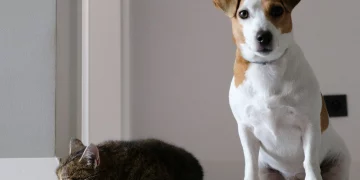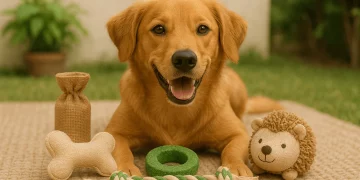Introduction:
Cutting your pet’s nails is an essential part of their grooming routine. Long nails can cause discomfort, lead to posture problems, or even cause injury to your pet. However, the process of trimming a pet’s nails can be stressful for both the pet and the owner, especially if it’s not done properly. Many pet owners worry about accidentally cutting the quick—the sensitive part of the nail that contains blood vessels and nerves—which can be painful and cause bleeding.
To help you safely trim your pet’s nails without causing harm or distress, this guide covers the essential tips and best practices to ensure that both you and your pet are comfortable during the process.
1. Understand Your Pet’s Nails and Anatomy
Before trimming your pet’s nails, it’s important to understand the anatomy of a pet’s nail. A typical pet nail consists of several parts:
- The Quick: The quick is the pink or fleshy area inside the nail that contains blood vessels and nerves. Cutting the quick will cause bleeding and pain.
- The Nail Tip: The hard, keratin-covered part of the nail that you trim. This is the area you want to cut, but you should avoid getting too close to the quick.
Understanding where the quick is located can help you avoid cutting it. In lighter-colored nails, the quick is often visible as a pink area, making it easier to avoid. However, in dark nails, it’s more difficult to see, so caution is needed.
2. Tools You’ll Need
Choosing the right tools is essential to ensuring a smooth and safe nail-trimming experience. Here are the tools that are most commonly used for pet nail care:
- Nail Clippers: There are different types of nail clippers for pets, including scissor-style, guillotine-style, and plier-style. Choose one that suits your pet’s size and the type of nails they have.
- Nail Grinder: Some pet owners prefer using a nail grinder instead of clippers. A grinder slowly grinds down the nail, reducing the risk of cutting too much off and hurting your pet. However, it may take longer, and your pet might not like the vibration.
- Styptic Powder: In case you accidentally cut the quick and cause bleeding, styptic powder is useful for stopping the bleeding quickly.
- Cotton Balls or Tissue: If bleeding occurs, you can use cotton balls or tissues to apply pressure to the wound.
3. How to Prepare Your Pet for Nail Trimming
Preparing your pet before the nail trimming session is crucial for their safety and comfort.
- Choose a Quiet, Calm Environment: Pick a quiet room with minimal distractions. Make sure your pet feels safe and calm.
- Get Your Pet Used to Handling Their Paws: Before attempting to trim their nails, get your pet accustomed to having their paws touched. Gently hold their paws, massage them, and reward them with treats to make the process more positive.
- Use Positive Reinforcement: Reward your pet with treats, praise, or playtime for calm behavior during the preparation phase. This helps them associate nail trimming with positive experiences.
- Enlist Help If Needed: If your pet is particularly squirmy or anxious, it can help to have someone assist you in holding your pet still during the trimming process.
4. Step-by-Step Guide to Nail Trimming
Here’s a step-by-step guide to trimming your pet’s nails safely and effectively:
- Positioning Your Pet: Place your pet on a non-slippery surface. You may want to place them on your lap, or you can use a table if your pet is comfortable with it. Ensure they are secure but not overly restrained, as this can cause stress.
- Hold the Paw Gently: Gently lift and hold your pet’s paw, positioning their nail so that you can see the tip. Hold the paw firmly, but not too tightly—your pet should still feel comfortable.
- Examine the Nail: Look closely at the nail to determine where the quick is. For clear or light-colored nails, the quick is usually visible as a pink area inside the nail. For dark nails, you can trim small sections at a time to ensure you don’t cut too close to the quick.
- Trim the Nail Gradually: Using your chosen tool, trim only the tip of the nail. Be sure to clip in small increments, especially if your pet’s nails are long, to avoid cutting the quick. If using a grinder, move slowly and gently to avoid causing your pet distress.
- Avoid Cutting Too Close: For light-colored nails, trim just before the quick, but avoid cutting into the pink area. For dark nails, trim little by little until you see a solid, white area—this indicates you’re close to the safe point.
- Take Breaks: If your pet is becoming anxious or if you’re unsure about your cuts, take breaks. Offer treats, play, and keep your pet calm. It’s better to break the session into shorter, positive experiences than to rush and cause stress.

5. Signs You’ve Trimmed Too Far
It’s important to know when to stop trimming to avoid cutting the quick and causing pain or bleeding. If you see the following signs, stop immediately:
- Bleeding: If you accidentally cut the quick, bleeding will occur. Don’t panic—apply styptic powder to stop the bleeding and give your pet a chance to calm down.
- Visible Pain: If your pet shows signs of discomfort, such as yelping, pulling their paw away, or becoming very agitated, stop trimming and check for signs of injury.
6. How to Handle Accidental Quick Cuts
Even experienced pet owners can accidentally trim too far and cut the quick. If this happens, don’t worry—it’s not the end of the world. Here’s what to do:
- Apply Styptic Powder: Styptic powder can be applied directly to the bleeding nail to stop the blood flow quickly. You can also use cornstarch as a natural alternative.
- Apply Pressure: Use a cotton ball or tissue to apply gentle pressure to the nail for a few minutes to control the bleeding. Most bleeding will stop within a few minutes.
- Stay Calm: Your pet will be more stressed if they sense your panic. Stay calm and comfort your pet during the process. Afterward, reward them with praise and treats to reinforce the positive experience.
7. When to Seek Professional Help
If you’re unsure about cutting your pet’s nails or if your pet is particularly anxious or uncooperative, it’s best to seek professional help. Many veterinarians and groomers offer nail trimming services and can trim your pet’s nails safely. If your pet has special needs, such as health conditions that affect their nails, consult your veterinarian for advice.
8. Conclusion
Trimming your pet’s nails may seem like a challenging task, but with the right tools, preparation, and approach, it can be a safe and effective part of their grooming routine. Remember to take your time, remain patient, and always prioritize your pet’s comfort and well-being. By gradually getting your pet used to the process, using the right techniques, and being cautious not to cut too far, you can ensure that nail trimming becomes a positive experience for both you and your furry friend.























































